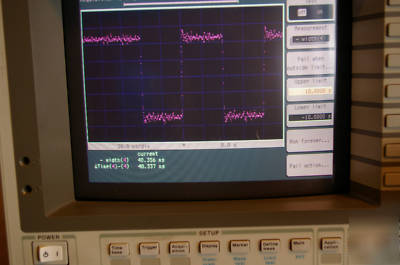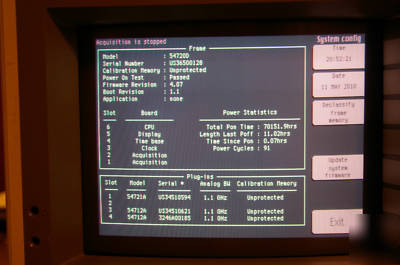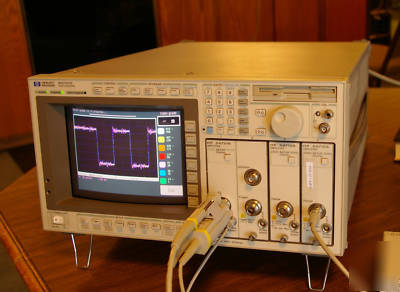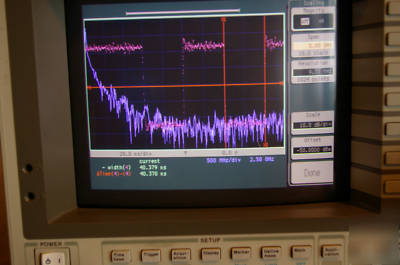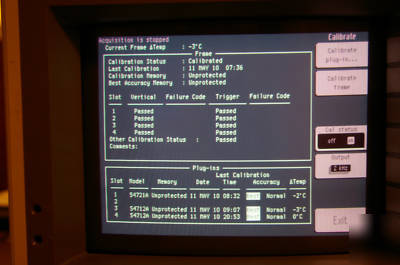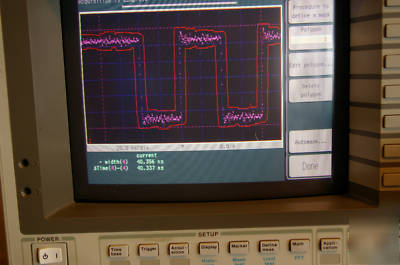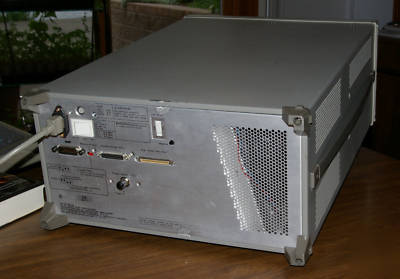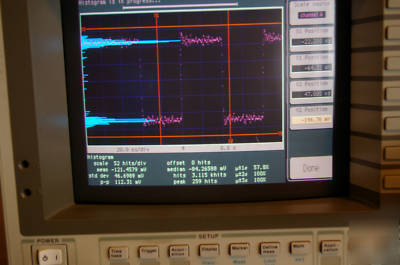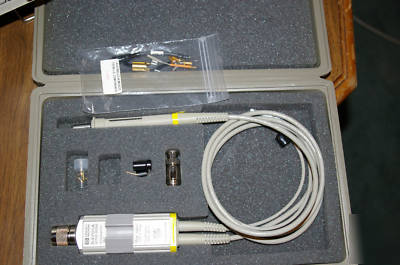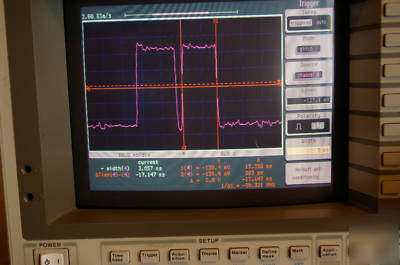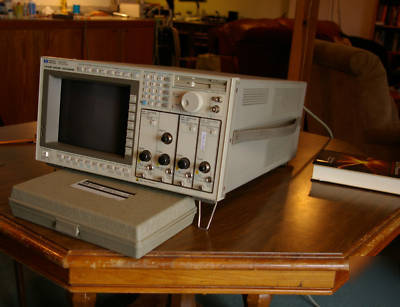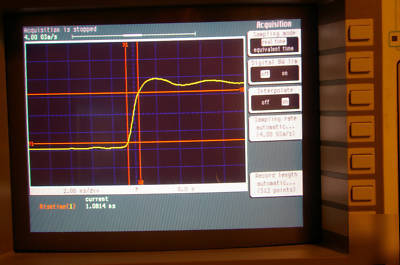Tristate Machinery Dismantlers Forum > MICHIGAN
> Industrial Machines
> New
> Without Warranty
> 54720D 4GSA/s 1.5 ghz digital oscilloscope beats 784A
54720D 4GSA/s 1.5 ghz digital oscilloscope beats 784A
1. 54721A plug-in (4 GSa/s 1.1 GHz Bandwidth) with 54701A (10:1 10K .6pf active probe)
2. (The 54721A is a 2 slot plug-in)
3. 54712A plug-in (2 GSa/s 1 GHz Bandwidth) 50 Ohm input
4. 54712A plug-in (2 GSa/s 1 GHz Bandwidth) 50 Ohm input
The Display on this scope is high quality I have cleaned the 54720D up inside and out. I replaced the Lithium battery, and loaded the last EEPROM based operating system which includes FFT, Histogram, Mask, and limit testing. This is a great high performance troubleshooter. With a 54701A active probe, it is ready to use. It passes all self-tests and is fully calibrated. It includes most of the probe accessories. What you see is what you get. Let me know if you would like a different configuration.The pictures are from the actual product. You can glean a lot of functionality by studying the pictures.
The 54720A/D has a color graded display
Equivalent and real time sampling
Autoscale to find signals
Math functions, Auto measurements, FFT, Mask, Limit test, Histogram
8 Bit A/D with 12 bit vertical resolution equivalent time averaged.
30 ps time-interval accuracy (equivalent time)
25-ps time-interval accuracy (real time)
Complex triggering, advanced logic triggering, 500 ps glitch capture,
2.5-GHz, 0.6-pF active probing 54701A
3.5-inch, MS-DOS-compatible disk drive
A memory bar display helps navigate waveforms captured in memory.
Plug-in Selection and Characteristics (w 1:1 probe)
v Channel Bandwidth depends on the plug-in chosen. The mainframe bandwidth limit is 1.3GHz in the 54720A or 2 GHz in the 54720D. The plug-ins provide signal conditioning, attenuation, or amplification, to present a properly scaled signal to the A/D converters into FISO memory in the mainframe.
v Channel Sample rate depends on the plug-in selected. 2GSa/s A/D converters with FISO memory are in the mainframe behind each of the 4 slots. 2 slots can be interleaved to achieve 4GSa/s (54721A), and 4 slots interleave for 8GSa/s (54722A). Interleaving extends memory depth. See the table above for memory depth information ..
v User adjustable sample rate lets the user decide how much time span to capture. Behind each A/D converter there is 16K of memory in the 54720A, and 64K of memory in the 54720D. So if the user lowers the default sample rate, capture time is extended.
v Probes!! The higher freq plug-ins are 50 ohms input only. They will require an active probe (54701A) or resistive divider probe like the 54006A for general trouble shooting. (50 Ohms would overload most circuits.)
v The 54713A/B and 54714A are good general purpose plug-ins. They have selectable 50 ohm or 1Meg BNC inputs for normal passive probes. (like the 54503A series scopes) They use normal 10400 series 10:1 probes.
v Sensitivity is limited on the 50 Ohm plug-ins and some plug-ins do not have normal BNC input connectors. Look at the pictures!
The HP 54701A Active Probe has input resistance of 100 k Ohms, Input capacitance 0.6 pF , and Division Ratio 10:1.
When used with Bandwidth Maximum sensitivity
The HP 54006A Passive 50-W Divider Probe Input resistance 500 W (10:1) or 1000 W (20:1)
Input capacitance Typically 250 fF , Division Ratio 10:1 or 20:1
HP 54711A 1.5 GHz 20 mV/div (10:1) or 40 mV (20:1)
HP 54712A 1.1 GHz 10 mV/div (10:1) or 20 mV (20:1)
HP 54721A 1.1 GHz 10 mV/div 10:1) or 20 mV (20:1)
HP 10430A 1-MW Passive Probe Input resistance 1 MW Input capacitance 6.5 pF
! Note the 54714 is a multiplexed (2 channel) 54713A so if you had four 54713A s you could have eight channels
! Note there is also a 54718A EXT trigger plug-in which can be used for Ext triggering
Electronic condition Passes all tests and is fully calibrated. New Lithium battery!
Cosmetic condition Nice clean front panel see the pictures Chassis and feet are in good shape. Really a nice clean unit inside and out! No CRT burn-in! Good bright CRT.
Warranty Contact me for fair resolution on any problem.
Thanks for looking. Feel free to contact me with questions.
Of course not all units can be repaired. I disassemble these units for parts. Agilent has classified many of these units as obsolete and parts are not available from Agilent. I have accumulated many of the obsolete parts and many are listed in my store watronics92 I will run the auto self cal on any unit I sell, but I do not have an ISO certified lab. Any unit I sell will pass calibration at an ISO calibration lab.
Choosing the right scope for your application
You need to purchase the right scope for your application. In general the first consideration is bandwidth, but bandwidth is not that simple. You need to be aware of the bandwidth in both the Single Shot / Real Time mode as well as the Repetitive mode.
Repetitive mode In the repetitive mode the waveform is constructed by triggering and acquiring data on successive repeating events. If the particular signal of interest is repetitive like a system clock, then a very accurate waveform can be constructed from repeated acquisitions. Data is randomly captured into a circular buffer through an A/D converter. Then a fine interpolator is used to precisely (40 psec or better) measure the time between the last sample taken and the analog trigger event. Data can now be placed in a memory buffer precisely positioned in time. With successive acquisitions, the buffer is eventually filled. High bandwidth can be achieved with relatively slow but accurate less expensive A/D converters.
Real Time / Single Shot mode In this mode, the entire waveform must be captured on a single trigger. Naturally this requires a very high performance FAST A/D converter. The fine interpolator is still used to place data precisely relative to the analog trigger event.
The bottom line on bandwidth If you are trouble shooting and looking for a rare glitch that might cause an error in your system, you need to think about Real Time / Single Shot bandwidth . On the other hand if you are designing a clock distribution system and are looking at repetitive clocks, then repetitive bandwidth will work fine for you.
Bandwidth, Sample rate, channel count, memory depth, and trigger features must all be considered. If you are trouble shooting logic circuits, the complex trigger features will be very important.
Of the scopes I sell, the HP 54501A and the 54503A are optimized to be high bandwidth repetitive scopes. They do have a low bandwidth single shot capability.
The 54502, 54504, and the 54510A/B are the Single Shot scopes designed for Single Shot work. They could easily have 500 MHz repetitive bandwidth like the 54503A but their analog bandwidth has been dinged slightly to prevent aliasing during digital reconstruction. The 54510A has a 1 GSa/s A/D converter so the sample interval is 1 nsec. We like 4 samples per period for reconstruction so a 250 MHz signal (4 nsec period) would be sampled 4 times by a 1 GSa/s A/D.
The 54720D is the very best of both worlds.
This is a 6 bit A/D converter. All the others are 8 bits.
**Special feature called sequential capture.
